Combat ships. Cruisers. A family of perfect pirates
Let's agree right away: not "pocket battleships", not "nedolinkors". Heavy cruisers. Yes, in terms of weapons, they were somewhat beyond the class, but the 283 mm was by no means the caliber of a battleship at that time. 356 mm, 380 mm, 406 mm - these are the calibers for the battleship. And 283 mm is like the Soviet light cruisers of Project 26, there was a 180 mm main caliber. But this did not make Kirov and its comrades “pocket heavy cruisers”. These were ordinary light cruisers, on which more powerful guns were installed. No more.
The Deutschlands were not ordinary and normal cruisers, but the main caliber here certainly does not play the most important role. However, in fact, these were ships out of class, somewhat outside the general concept of heavy cruisers. We will take the liberty of going over them in some detail.
But let's go in order.
And the order was like that. In post-war Germany, of course, they heard about the Washington Agreements and thought what it was and how to deal with it. With the help of excellent German intelligence, all the data was soon on the table at the General Staff, and in 1924, when the really cool Admiral Zenker (the commander of Von der Tann in the Battle of Jutland) became the head of the remnants of the German Navy, the process just rushed off.
Zenker and the company, having analyzed the data on the Washington cruisers, decided that they should be opposed by a cruiser that could easily get away from the battleships of that time, that is, having a speed of more than 23 knots and having artillery between 150 mm and 380 mm.
That is, on the one hand, this cruiser had to easily cope with a light cruiser, calmly deal with a heavy one and, if necessary, simply escape from the battle cruiser at the expense of speed.
I must say, looking ahead, that the Germans implemented the idea 100%.
There was, however, a huge problem. There were no guns. Not only were there none, there was no way to make them. Weapons Krupp's factories remained in the French-occupied Ruhr zone. In connection with this fact, Krupp could guarantee the supply of ... ONE barrel with a caliber above 210 mm per year.
Nevertheless, the German command took a risk and began to design ships. And in 1925, after long backstage negotiations, France withdrew its troops from the Ruhr. And, by the way, no one raised more questions about the production by Germany of the 280-mm and 305-mm guns "prohibited" by the Versailles Treaty.
And in 1927, a competition was held in which the high command fleet, Admirals Zenker, Mommsen, Bauer and Raeder, considered the proposed options, of which there were three.
Option "A": 4 guns 380 mm, main armor belt 250 mm, speed 18 knots.
Option "B": 4 guns 305 mm, armor belt 250 mm. The speed is 19 knots or armored belt 200 mm, and the speed is 21 knots.
Option "C": 6 guns 280 mm, armor belt 100 mm, speed 27 knots.
Three of the four admirals voted for Option C. Only the future commander of large ships, Raeder, was against.
When the world learned about what the Germans would build, everyone was a little stunned. But it was too late to slow down, Germany was not invited either to Washington or London, so the Germans did what they wanted. And nobody liked what they were doing. The French in general began to urgently develop a response in the form of a battle cruiser with a 17 ton displacement, with six 000 mm guns and a 305 mm armor belt.
It turned out that the Germans did not violate the Washington and London agreements, since they did not sign them, and the Versailles ... But who in the 30s remembered this Versailles, there was no time. In general, the Versailles Agreement, which for Germany was more stringent in terms of restrictions than Washington, the Germans simply violated.
But Washington was also violated by everyone who really needed it. Therefore, no one particularly condemned Germany's going beyond the limit, because everyone had a snout not only in fluff, but in something more serious.
So the fact that Deutschland weighed 10 tons, Scheer - 600 tons, and Spee - 11, were "forgiven". It was not up to that, since it became clear that no one would disassemble the ships, which means that it was necessary to somehow answer the Germans.
In terms of the full load of the cruiser, there were also handsome men: Deutschland - 15 200 tons, Admiral Scheer - 15 900 tons, and Graf Spee - 16 200 tons.
In different sources, the total displacement figure floats great, this is due to both the lack of documents that were burned down in Hamburg from the bombings, and the mess that reigned in the world in terms of estimates between "long" British tons and conventional metric tons. Confusion took place everywhere, and everyone took advantage of it, "cutting" a little of their ships.
What were these cruisers like? It is worth considering in detail here, because all the conclusions will be after.
Power plant
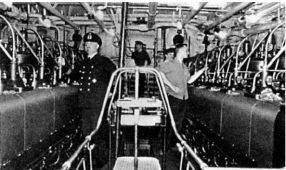
A masterpiece, because a diesel from MAN. The risk was huge, with economical diesel engines on the same Leipzig, the Germans suffered throughout the war, and, I think, they breathed a sigh of relief when the Prince Eugen rammed the Leipzig. It was when he stood, switching the settings of the course.
You might call it a miracle, but the Mana engineers did something like that. The power plants worked perfectly, and the Deutschlands became very interesting ships in terms of energy. The Admiral Scheer covered 161 miles in its first pirate raid in 46 days without any engine trouble. Nobody dreamed of this.
All three ships had the same diesel engines: 8 main engines, M-9Zu42 / 58, 9-cylinder with a maximum power of 7100 hp each. at 450 rpm (maximum continuous power of 6655 hp) and 4 auxiliary 5-cylinder, M-5Z42 / 58 models (maximum power of 1450 hp at 425 rpm).
Weight per horsepower was 11,5 kg - a very good result for a diesel installation, traditionally considered quite heavy.
8 main motors were grouped in 4 compartments in pairs, four motors per shaft. The engines in the compartments that were closer to the bow rotated the right shaft, the stern ones - the left.
The main advantage of diesel engines was their fantastically huge cruising range. Fully refueled - 20 miles, and at a pretty decent cruising speed.
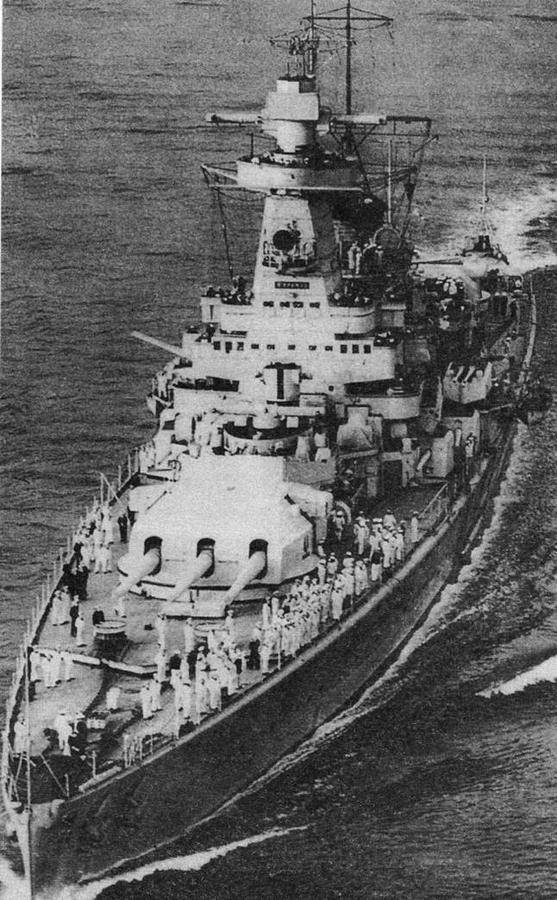
"Graf Spee" on tests showed that it can go 16 miles at an average speed of 300 knots. And at a maximum travel of 18,6 knots - 26 miles. More, by the way, than that of the main majority of battleships of that time on an economical course.
That is, the cruisers had the chances to simply escape and dissolve in the ocean from the very beginning. In addition, the diesel engine was distinguished from boiler and turbine installations by one more important quality: under them the ships picked up speed very quickly. Traditional boiler and turbine installations required a maximum steam pressure, which could be achieved in an hour or an hour and a half, depending on the mode.
And a diesel cruiser could calmly give full speed to 27 knots and either escape if it got to the wrong place, or covertly approach, taking advantage of the fact that the enemy could not quickly give full speed.
This had to be paid for with noise and vibration. What was, what was. The eerie hum of eight diesels at full speed made the crew communicate in notes. And vibration had a negative effect on communication devices and fire control.
Reservation
The reservation system is one of the most interesting distinguishing characteristics of these distinctive ships. She completely departs from the canons adopted in the German fleet during the First World War and has no analogues among foreign ships of the cruiser class. And it's not even about the bare numbers, the same Wheatley has enough of them.
It is important that in terms of booking, the three cruisers can hardly be called the same type. Booking schemes differ so that we can say that these are three variants of the same idea of booking a ship.
On the Deutschland, the armor belt consisted of two layers of steel, each 80 mm thick. Towards the bow and stern, the thickness of the lower layer decreased to 18 mm. Down from the armored deck to the inner plating of the double bottom, an armored bulkhead 45 mm thick was parallel to the belt. Above the armored deck there was an upper armored bulkhead 10 mm thick, which was located strictly vertically and reached the upper deck. The deck was 45 mm thick at the thickest part, above the citadel.
It should be noted that the projectile, which should have penetrated the hull of any of the cruisers, encountered many armor barriers on its way. Mostly inclined, that is, having a great chance to deflect the projectile.
On the possible trajectories of the projectile, the following combinations were obtained (from top to bottom):
- 18mm upper deck + 10mm vertical bulkhead + 30mm deck;
- 18mm upper deck + 80mm belt + 45mm deck;
- 80mm belt + 45mm bulkhead;
- 50 mm inclined belt slab + 45 mm inclined bulkhead.
Such a reservation system in total gave from 90 to 125 mm of armor with a successful combination of slopes and verticals. None of the "Washington" cruisers in the world possessed comparable armor. Theoretically, such a protection system was supposed to withstand shells of calibers 120-152 mm at almost all combat distances, except for point-blank shooting.
The towers were also an interesting design. A complex polyhedron with many ricochet angles. The thickness of the frontal plate is 140 mm, the side plates are 80 and 75 mm in the front and rear parts, the front part of the roof is inclined downwards - 105 mm, the flat and rear inclined part of the roof is 85 mm, the side inclined fragments are from 80 to 60 mm. The maximum thickness of the rear wall was 170 mm, but it was made of ordinary steel and played the role of a balancer.
The auxiliary caliber could not be booked so luxuriously. Eight single-gun mounts were protected only by 10 mm thick tower-like shields. The shields completely covered the crew, but they were very cramped and not very comfortable.
Unlike the main caliber, the 150-mm artillery ended up in the stepdaughters. Due to the obvious impossibility of providing reasonable protection for 8 single-gun installations, the designers had to limit themselves to 10-mm tower-like shields, although completely closed, but too cramped and uncomfortable.
The main conning tower had 140-mm walls made of Krupp's cemented steel and a 50-mm roof made of nickel. The stern and artillery post had 50 mm wall armor and 20 mm roof. The rangefinder post on the formars and the anti-aircraft fire control posts had protection of 14 mm.
The protection of the next cruiser, the Admiral Scheer, differed from that of the lead ship in both location and materials. The sloped belt armor also consisted of two layers, but the 80mm plates were in the lower row, and the 50mm row was higher.
The anti-torpedo bulkhead was made thinner, 40 mm instead of 45, but was made of Wotan steel. The upper splinter-proof bulkhead also became 40 mm thick. The protection of the rudders was strengthened: the deck in the stern was now 45 mm, 45 mm had a belt in the stern and traverses closing the steering compartment. The steering compartments were protected from all sides by 45 mm armor.
The barbets "got fat". 125mm new generation armor, Wotan Harte. The main wheelhouse received another 10 mm of armor on the side walls, the artillery posts were booked with 20 mm plates.
In general, the Scheer received a more thought-out booking scheme; by and large, only the upper deck remained open.
On the third ship of the series, Admiral Graf Spee, the booking has also changed somewhat. The belt is narrower than on the Deutschland. Differences in belt height on cruisers are clearly visible in the photographs.
weaponry
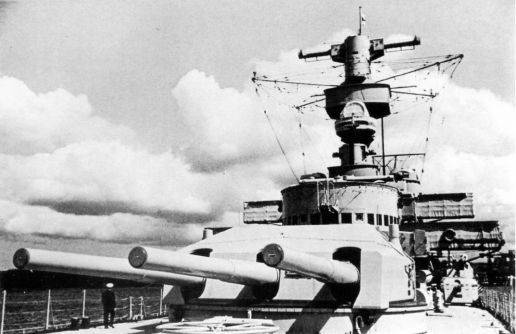
The main caliber, of course, became the "trick" of these ships. Probably, having missed work, German gunsmiths designed a new weapon, although since the First World War they had a pretty decent set of developments with good ballistic data.
The 28 cm SKC / 28 gun had a true 283 mm caliber according to the German system.
The maximum rate of fire reached three rounds per minute, practical - no more than two. The projectile had a high muzzle velocity of 910 m / s, but despite this, the barrel survivability was quite: 340 rounds with a full charge, that is, about 3 full ammunition.
The ammunition consisted of three types of shells: armor-piercing and two types of high-explosive, instantaneous action of the fuse and with deceleration. Due to the correctly selected shape and weight (300 kg), the shells had the same ballistics.
The auxiliary caliber consisted of eight 150 mm SKC / 28 guns, which were also developed specifically for cruisers.
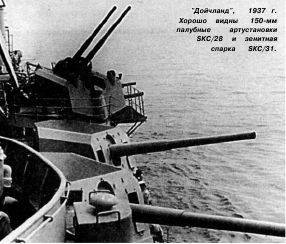
The gun fired 45,3 kg shells with a bottom or head fuse at an initial speed of 875 m / s. The maximum rate of fire reached 10 rounds per minute, in practice it did not exceed 5-7 volleys per minute. Barrel survivability - over 1000 full charges.
150-mm guns had large sectors of fire along the horizon. The ammunition capacity was 150 rounds per gun. In general, 8 x 150 mm is the armament of another light cruiser. But on the Deutschlands, these guns played the role of raider weapons. Well, really, do not shoot at transports from the main battery?
But it cannot be said that the auxiliary caliber was effective. Yes, it was quite possible to sink a dry cargo ship, but it was necessary to make a fire control post or something ... Many experts pointed out that 150-mm guns were a weak link in the cruiser's armament, since they were both defended and controlled according to the residual principle. And in general, it would be possible to do without them by stabbing anti-aircraft guns wherever possible.
However, if you remember that this is primarily a raider, then everything will become normal. Control posts are not needed to shoot a civilian steamer. And ships such as a destroyer or light cruiser can easily drive away the main battery. But this opinion is not an axiom.
Flak
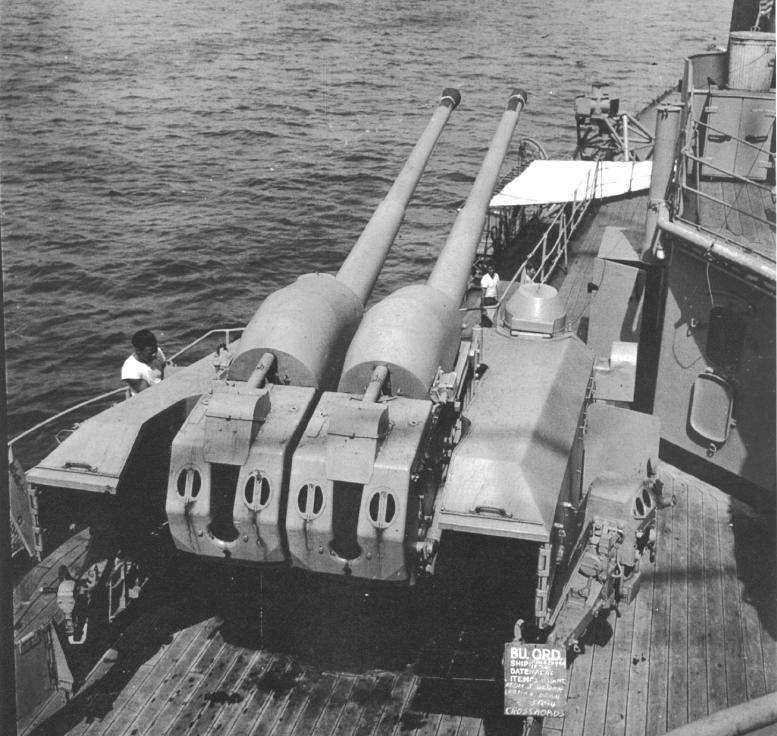
Anti-aircraft artillery is an evolution. When the Deutschland entered service, the threat from the sky was opposed by as many as THREE anti-aircraft guns of 88 mm caliber with separate loading of the 1914 model. It is clear that as soon as it became possible, the guns were sent to museums, and in their place were installed paired installations of the same caliber, but of the 1931 model. With an electric drive, stabilized in three planes ... Unitary cartridges of 15 kg weighing a projectile weighing 9 kg at a distance of up to 10 m with an initial speed of 000 m / s.
They were very good weapons. Deutschland and Scheer were equipped with them. On the Spee, engineers went even further, installing barrels in successful installations. And instead of 88 mm they put 105 mm. The projectile weighing 15 kg flew about the same distance, but a little slower - 900 m / s.
In addition to these guns, each cruiser was to receive eight 37-mm SKS / 30 assault rifles in twin L / 30 mounts. These machines were also stabilized, but in two planes.
Torpedo armament
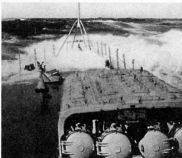
Two four-pipe 533-mm torpedo tubes were placed in the aft of the ship. There they, in which case, could not do much harm in the event of an emergency situation in battle. The apparatus was covered with light (5-mm) shields, protecting not so much from shrapnel as from the powder gases of the rear tower.
Aircraft Armament
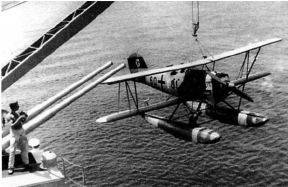
The standard for cruisers of that time: two seaplanes (first "Heinkel" He.60, then "Arado" Ar.196) and one catapult. But in fact there was always only one plane on board, which is why at one time they gnawed their elbows on the Scheer, having failed in Wonderland.
Control systems
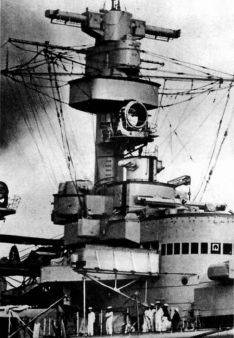
Everything was luxurious with control systems. For just two towers. I would say that it is even unnecessary. But if we again remember that we are not facing a combat cruiser, but a lone raider, everything again falls into place.
Three rangefinder posts (two with 10-meter rangefinders, one with 6-meter). Target designation could be conducted from FIVE equivalent sighting posts! Two in turrets at the conning tower, two on fore-mars at the 10-meter rangefinder, one at the stern, also next to the backup rangefinder.
All posts were covered with 50 mm armor. The observation was carried out exclusively with the help of periscopes, no hatches and cracks. The data from the posts went to two processing centers located under the bow and stern wheelhouses deep under the armored deck and equipped with analog computers. It was unique and unmatched at that time.
In fact, the auxiliary caliber could also be controlled by means of so many posts, especially since the 150-mm guns had their own data processing post in the hold. But this post was "for two", that is, anti-aircraft gunners also used it. And since the threat from the air was present almost constantly, it is clear that the computer center was occupied by anti-aircraft gunners.
For the normal operation of air defense systems on the "Deutschlands" in 1943, a new anti-aircraft KDP SL2 appeared, stabilized in three planes and made it possible to transmit the correct data with a roll up to 12 °. Two such posts were installed on each cruiser. The posts also had their own 4-meter rangefinders.
With anti-aircraft guns, everything was not so rosy. More precisely, nothing at all. Until the very end of the service, the Sheera and Lyuttsov assault rifles fired under local control, using portable meter rangefinders.
And that's not all, no! For operations at night, command of the ship was envisaged from a special bridge located above the commander's. There were special enlightened naval binoculars and periscopes, and since the speed of reaction was the main factor during night shooting, there were two additional fire control posts that had simplified equipment, but allowed remote firing with the main caliber.
In addition, on the night bridge there was a sighting post for controlling searchlights and two target designators for firing illuminating shells.
Radar equipment
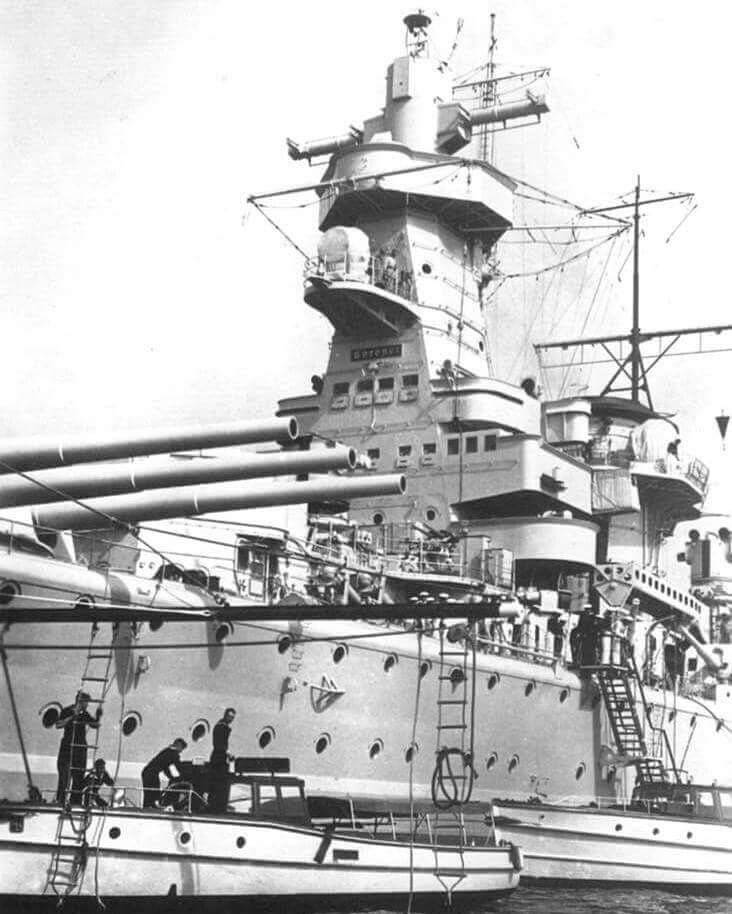
Here, the Deutschlands were also ahead of the entire Kriegsmarine. Already in 1937, a FuMG-39 radar was installed on the Deutschland. Experiments have shown the success of the radar, and in 1939 all three ships were equipped with the more advanced FuMO-22 system with a huge 2 x 6 m antenna. Scheer and Spee also received FuMO-27.
It is clear that in those years it was impossible to demand something fantastic from the locators, but they detected enemy ships quite confidently at 8-10 miles. But to fire using only radar data until the end of the war, the Germans did not risk it. There were mentions of "blind" shooting at targets on the shore, but no data on effectiveness.
Upgrades
In the first ocean voyages it turned out that the seaworthiness of the ships leaves much to be desired. The cruisers dug into the waves at high speed and constantly heated the stern compartments. Experts came to the conclusion that it is necessary to replace the stem with an "Atlantic", higher one.
Then they thought about the unification of weapons. There was a project to replace the 150-mm and 105-mm guns with the universal 127-mm. This replacement made it possible to significantly lighten the ship, strengthen the air defense (8 barrels per side), free up almost 100 crew. But the admirals did not like the idea, and they abandoned it.
In 1939, the Deutschland received four 20-mm assault rifles, in 1940 the 88-mm anti-aircraft guns were replaced with 105-mm, at the same time the cruiser received an "Atlantic" nose. In 1942, two 20-mm quadruple "firlings" and one 20-mm machine gun were installed instead of a searchlight. At the end of 1944, by that time already "Luttsov" had six 40-mm "bofors", four 37-mm and twenty-six 20-mm machine guns. Three "firling" naval modifications, with stabilization in three planes.
Sheer, like the later one, changed less. In 1936, two special "night" range finders for firing torpedoes in the dark and two 20-mm machine guns were installed.
In 1940, instead of a tower-like superstructure, a tubular mast of the Deutschland type was installed, but with a completely different arrangement of bridges and platforms. At the same time, the cruiser received an "Atlantic" stem, demagnetization device and an inclined visor on the pipe. The anti-rolls were removed. 88-mm anti-aircraft guns were replaced with 105-mm, and instead of two 20-mm machine guns installed two ground "firling" without stabilization.
In 1942, one of the searchlights was removed and two 20 mm machine guns were installed instead. The FuMO-22 radar was replaced by the FuMO-26, and the masts were equipped with means of passive detection of radiation from enemy radars "Java" and "Timor".
As it gets stronger aviation opposition also began. By the summer of 1944, in addition to the original 8 automatic 37-mm cannons, the Scheer had 4 firlings and 9 single 20-mm machine guns. Then part of the 37-mm twin-barrels began to be replaced with single-barreled 40-mm bofors.
According to the plan of rearmament in 1945, "Scheer" was supposed to have four 40-mm machine guns, four 37-mm machine guns and forty-two 20-mm barrels. The entire scope of modernization was not carried out and "Scheer" ended its war with four 40-mm barrels, eight 37-mm barrels and thirty-three 20-mm barrels.
"Spee" simply did not have time to modernize. The only modernization was the replacement of 88-mm anti-aircraft guns with 105-mm and the installation of a radar.
Combat application
"Admiral Graf Spee"
My career was not working out, let's face it. Indeed, "what do you call a yacht ..." Vice-Admiral Count Maximilian von Spee, who defeated the British in the battle at Coronel and died on December 8, 1914 on board the armored cruiser Scharnhorst in the battle of the Falkland Islands, also had a short career. Moreover, both carriers of the name von Spee died in approximately the same area.
On May 29, 1936, the cruiser became the flagship of the Kriegsmarine, and the first combat mission for the ship was the operation to remove German citizens from blazing Spain. Then there was a patrolling of the Atlantic sector assigned to Germany, adjacent to Spanish waters.
On August 5, 1939, the supply vessel Altmark, designed to work in tandem with the Spee, sailed for the United States. There, the tanker had to take a load of diesel fuel and dissolve into the ocean expanses until the moment the fuel is needed by the raider. On August 21, the Spee went to sea.
The ships got the southern sector of the Atlantic. There the cruiser and tanker met the beginning of the war.
On September 30, the battle score was opened by the sinking of the British steamer "Clement" (5 brt). In general, the commander of the "Graf von Spee" Langsdorff committed a lot of stupid things during his short command, but declassifying his position by radio messages was too much. Gentleness is a good thing, but not in such volumes, and even less so in a war.
Naturally, the news that two raiders were pirating in the Atlantic cheered up the British and French. For capture and rest, as many as 8 tactical groups were created and sent to the Atlantic, which included 3 aircraft carriers, 2 battleships, 3 battle cruisers, 9 heavy, 5 light cruisers and a couple of dozen destroyers.
For two heavy cruisers - more than an honor.
Much has been written about the famous battle at La Plata, it is not worth repeating the story of the battle. I can only say that Spee had a chance to butcher the British into a nut and leave. But apparently, the concussion of Langsdorf played its evil role, simply ditching a good ship, succumbing to the provocation of the insidious Britons.
From a purely technical point of view, the battle at La Plata can be considered a victory for the German cruiser. Two 203-mm and eighteen 152-mm shells that hit him did not cause him fatal damage. The main artillery of the Spee remained fully operational, only one of the eight 150-mm guns failed, and the two 105-mm mounts, which disabled the British shells, did not play a big role initially.
The Spee had neither roll nor trim, the vehicles were in perfect order. The loss of a crew of 1 people was 200 officer and 1 sailors killed and 35 wounded. But you can't say that about the British unit. The Germans pounded the Exeter so that the cruiser was not capable of combat. By the end of the battle, the artillery power of Harewood's detachment had more than halved, besides, only 58 shells remained on the most efficient Achilles. So a continuation could well have taken place.
The main loss can be considered the head of the commander Langsdorf, who actually capitulated to the circumstances. Like the commander of the "Bismarck" Lutyens in his time.
In general, Langsdorf cowardly blew up the ship and no less cowardly shot himself. That ended the career of the heavy cruiser Admiral Graf Spee.
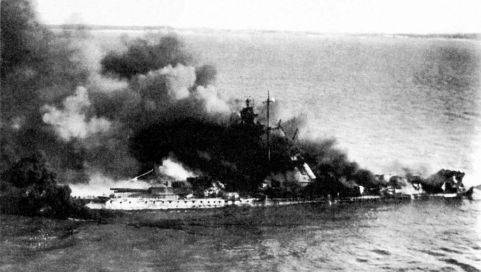
Deutschland - Lutzow
Let's just say: "Deutschland" was not the luckiest ship. Combat service began with Spanish operations, and each cruiser received some damage.
On May 29, 1937, the Deutschland was on the roadstead of the island of Ibiza, when at about 18.45 2 SBs from the "Group 12" - a small (10 aircraft) detachment of Soviet volunteer pilots appeared from the land side.
Our pilots confused the Deutschland with the Canarias and dropped bombs on it. Only two 50-kg bombs hit the ship, but they did something ... One bomb caused a fire and detonation of the ammunition of 150-mm gun No. 3. The plane burned down, the boat burned down. The second bomb also caused a fire, which detonated the shells of the 150-mm guns on the left side in the fenders.
Unexpectedly, as a result of being hit by two 50-kg bombs, 31 people died and 110 were injured, of which 71 were seriously. The cruiser went to Germany for repairs.
In 1939 "Deutschland" simultaneously with "Spee" went to the Atlantic for raiding. The cruiser got the northern part of the Atlantic, in which the ship had been waiting for an order to start operations for a month.
On October 4, 1939, the Deutschland opened an account by sinking the British steamer Stonegate. But the raiding was more than indistinct: two and a half months at sea resulted in less than 7000 tons of destroyed tonnage and one captured neutral transport that did not reach Germany.
The unsuccessful raid played a role in the renaming of the ship. In general, "Germany" could not screw up like that, could not be sunk. Therefore, since the heavy cruiser "Luttsov" was sold to the Soviet Union, the name seemed to be vacated. Not quite successful "Deutschland" was named "glorious", but very unsuccessful battle cruiser. The only one in its class who did not return from the Battle of Jutland.
The cruiser took part in the occupation of Norway, in one unit with the Blucher, which the intractable Norwegians had sunk. "Luttsov" got off with a slight fright, or rather, on the way back received a torpedo in the stern from a British submarine.
On June 12, 1941, having been assigned to work in the Atlantic, "Luttsov" and 5 destroyers went to sea. They were intercepted by British torpedo bombers and the cruiser received a torpedo in the side. The operation was canceled.
On November 12, 1943, having completed the repairs, he moved to Norway, replacing the Scheer. He took part in the infamous attack on convoy JW-51B on December 31. In fact, "Luttsov" passively did not take part in the battle, along with the destroyers, but only "Hipper" fought.
The contribution of "Lyuttsov" - 86 shells of the main caliber and 76 auxiliary ones fired towards the enemy.
In March 1944, she received the status of a training ship from the new commander of the Navy, Doenitz. The cruiser was transferred to the Baltic, where he supported the retreating German troops with his guns.
On April 16, 1945, while in Swinemünde, he came under attack from the British Air Force and was seriously injured. The ship landed on the ground, but continued to fire with its main caliber. As the Soviet troops approached, on May 4, 1945, it was blown up by the crew.
Admiral Scheer
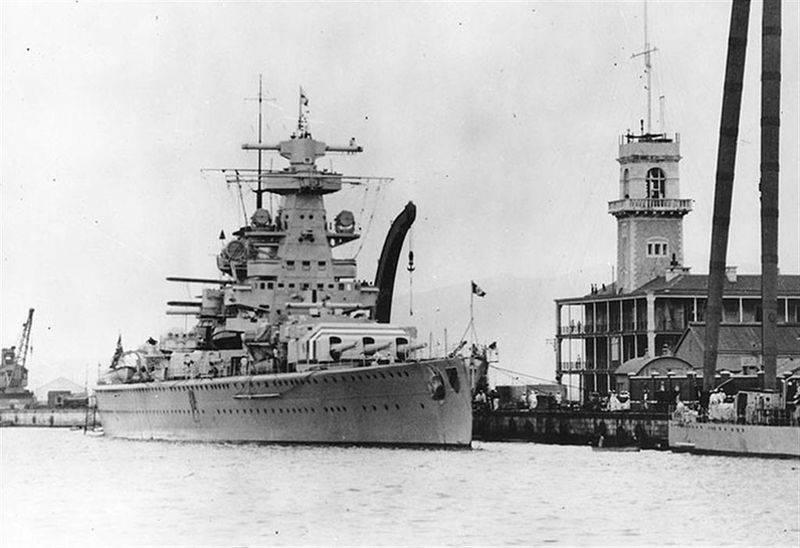
He received his baptism of fire in May 1937. In general, Sheer got the unsightly role of a sea terrorist. After the Deutschland air attack on May 29, Scheer, in accordance with the order of the command, fired 91 main-caliber rounds, 100 "intermediate" 150-mm and 48 anti-aircraft 88-mm rounds at the city of Almeria.
On November 5, 1940, he opened a battle score by sinking the British steamship Mopan. Then the raider found the convoy NH-84. Thanks to the heroism of the auxiliary cruiser Jervis Bay, which covered the convoy, the ships dispersed and Sheer was able to sink only 5 ships out of 37. Later, the raider sank two more ships.
The cruiser took part in an unsuccessful attack on the PQ-17 convoy. Then there was the inglorious operation "Wonderland" in the northern waters of the USSR. The operation ended with the sinking of the Soviet steamer "Alexander Sibiryakov".
At the beginning of 1945, the cruiser operated in the Baltic Sea, firing at the advancing Soviet troops. Having completely shot the barrels, he left for a replacement in Germany, where he was sunk by allied aviation in April.
Results
Really worth congratulating the Germans. In the 30s of the last century, they created really outstanding warships. The successful combination of very powerful artillery with enormous autonomy for those times and the strongest artillery in the class made the Deutschlands very difficult opponents for any cruiser.
An ideal raider - that is how these ships could be called. There were drawbacks, but there were also huge advantages. The whole question was just how to use these highly controversial cruisers.
Sources:
Vladimir Kofman. Pocket battleships of the Fuhrer.
Vladimir Kofman. Corsairs of the Third Reich.
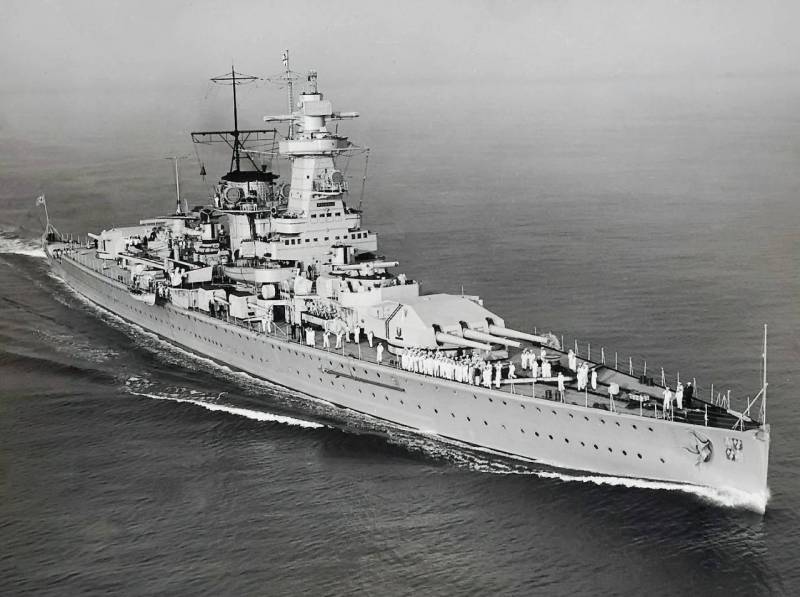
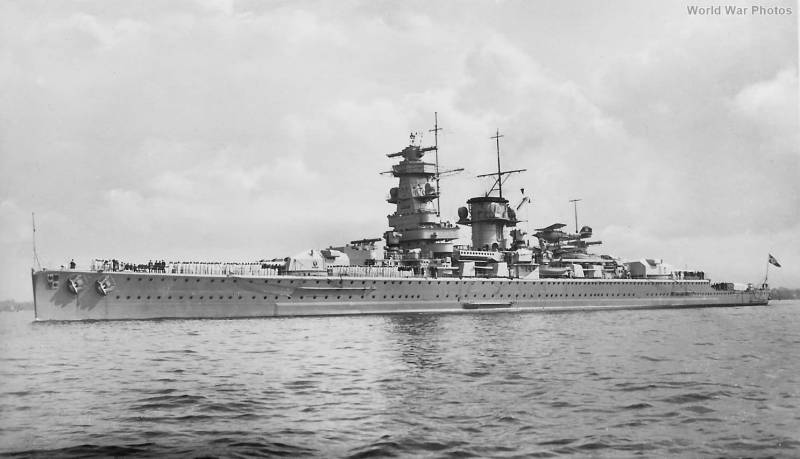
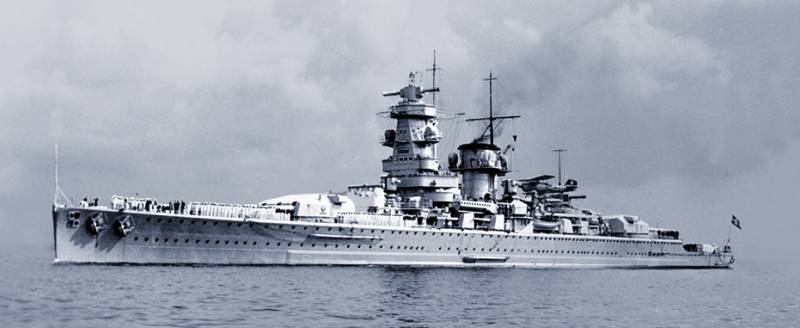
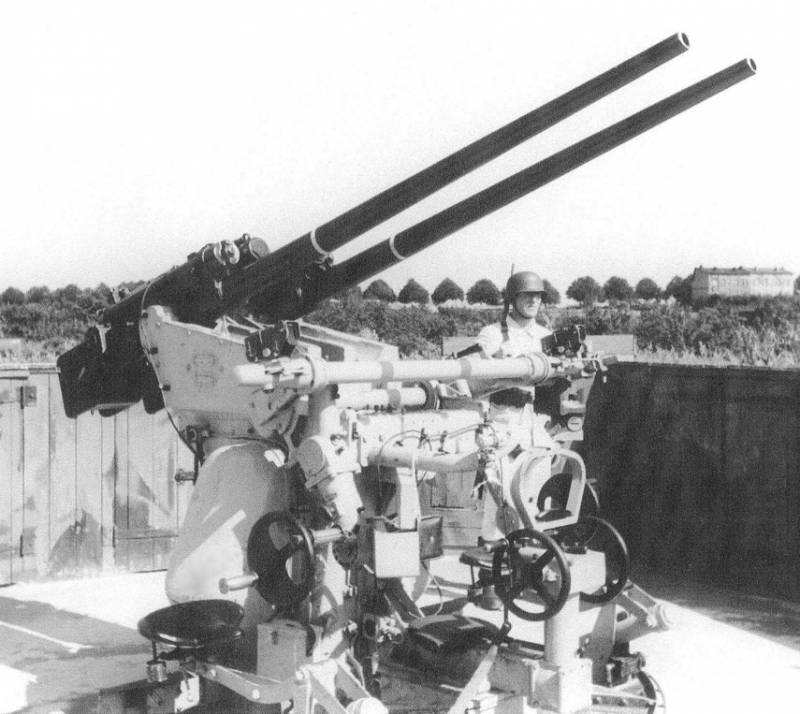
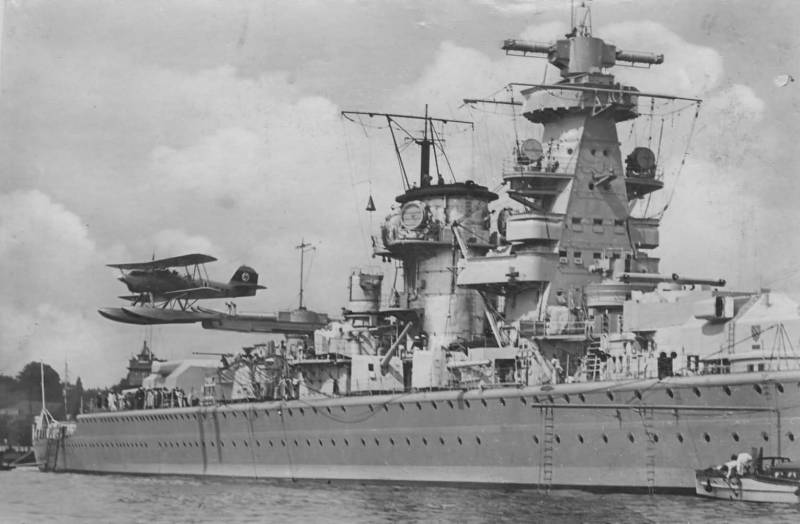
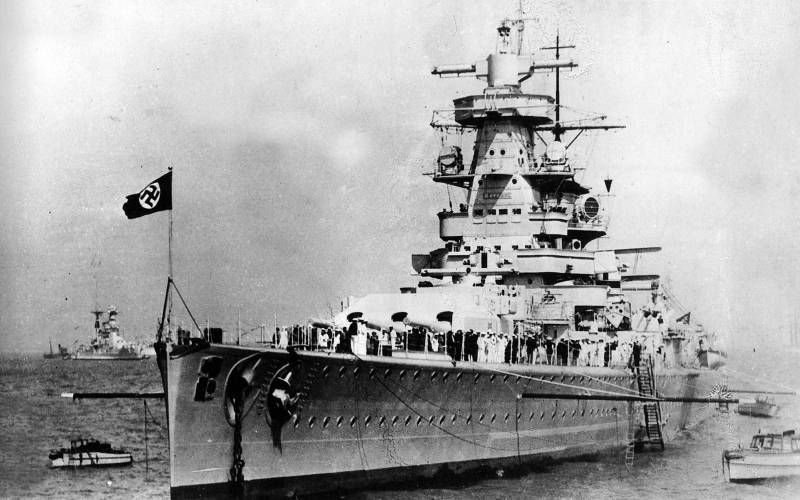
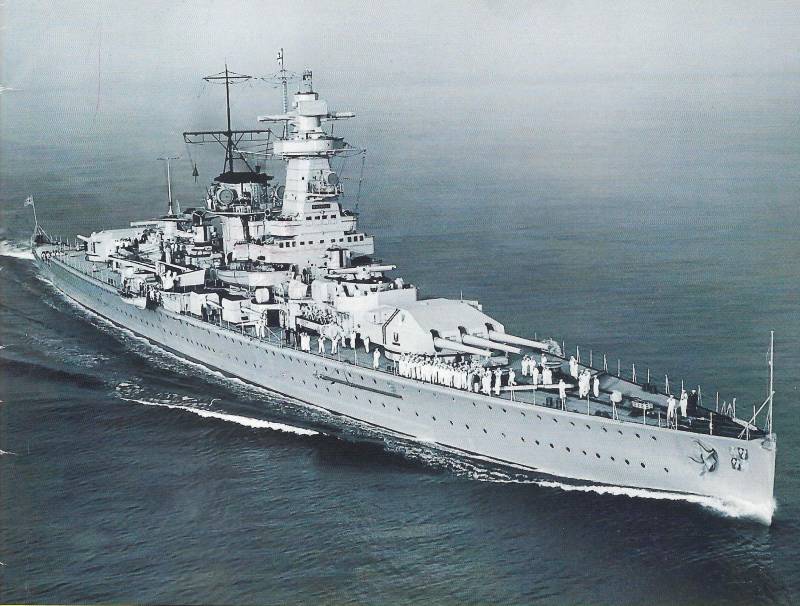
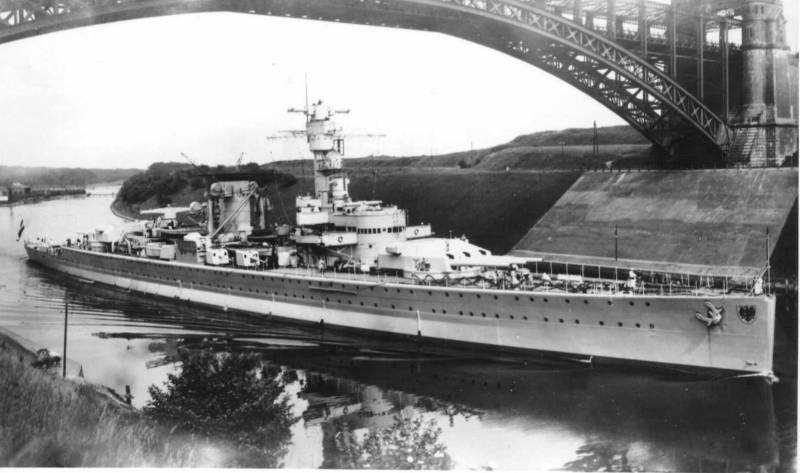
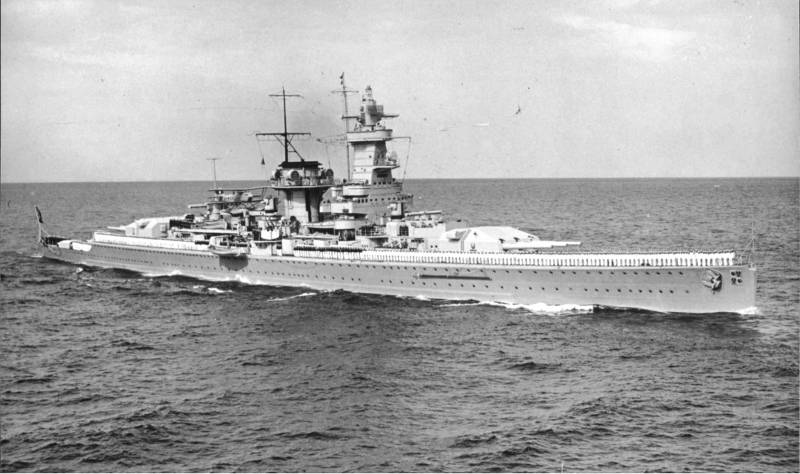
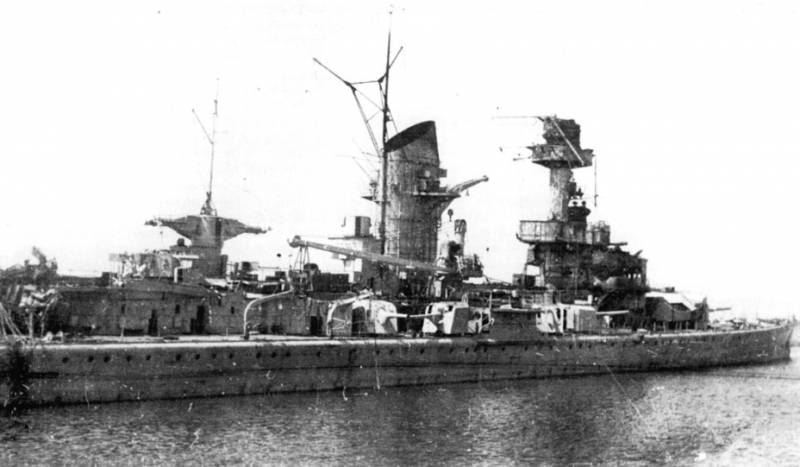
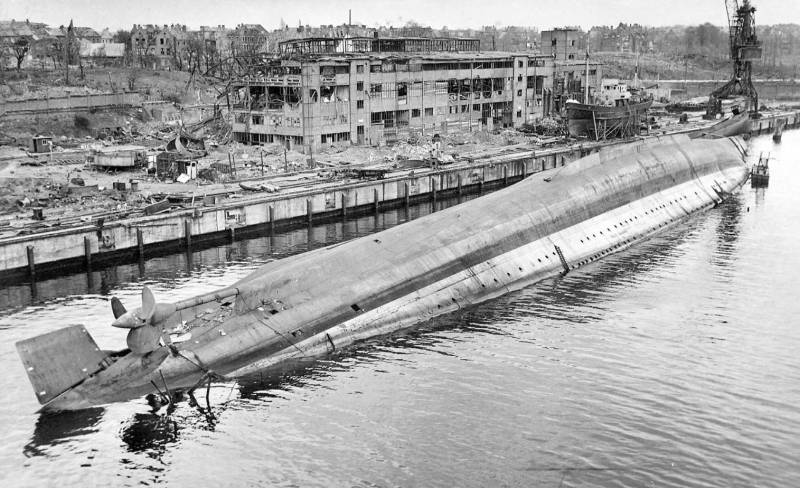
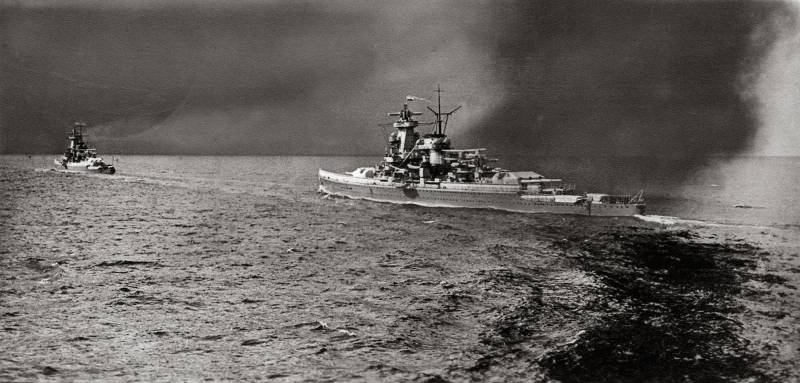
Information